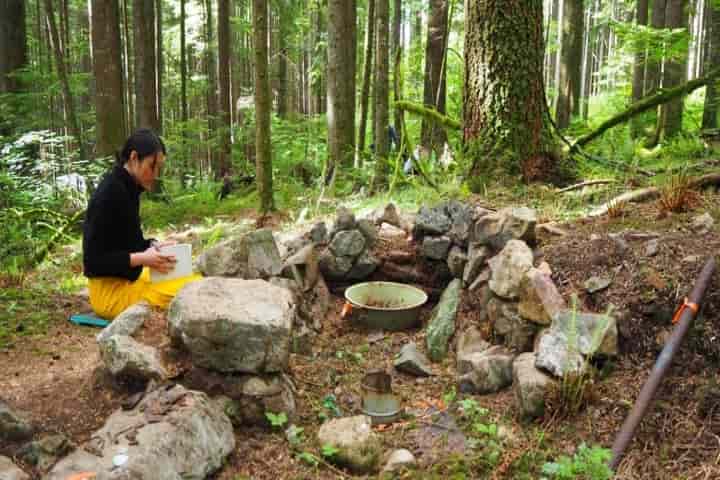

The excavation site where a remnants of a Japanese settlement were found (Pic: Courtesy cbc.ca)
<p>
<strong>The discovery of some minor items led to the finding of a mysterious settlement of Japanese, that too deep in a forest of British Columbia. Sound incredible but that is what Robert Muckle, who after coming to know of this place, found when he excavated the area.</strong></p>
<p>
Muckle, in the year 2004 became aware of a site in a forest located in British Columbia&rsquo;s North Shore mountains, where a few old cans and sawblade had been found. Intrigued he was but he never expected even in his wildest dreams that in the next 14 years of excavating of that area he will hit upon a historic logging camp.</p>
<p>
It was not just an ordinary camp but also a Japanese settlement, that was now forgotten, and which was abandoned all of a sudden.</p>
<p>
According smithsonianmag.com in a North Shore News report, Brent Richter mentions that more than 1,000 items had been dug up by Muckle and teams of students of archaeology from the area. Muckle <a href="https://www.smithsonianmag.com/smart-news/hidden-japanese-settlement-found-forests-british-columbia-180973028/">is an instructor at Capilano University in Vancouver</a>.</p>
<p>
The items discovered included teapots, sake bottles, rice bowls, buttons, pocket watches, and lots of fragments of Japanese ceramics.</p>
<p>
<iframe allow="accelerometer; autoplay; clipboard-write; encrypted-media; gyroscope; picture-in-picture" allowfullscreen="" frameborder="0" height="315" src="https://www.youtube.com/embed/PtMGyg-T2AY" title="YouTube video player" width="560"></iframe></p>
<p>
Muckle told Smithsonian that the &ldquo;locations of 14 small houses &hellip; a garden, a wood-lined water reservoir, and what may have been a shrine,&rdquo; were also discovered. Besides these, a vital aspect of Japanese culture, bathhouse, the remains of which too were found.</p>
<p>
The area is located in what is known as the Lower Seymour Conservation Reserve which lies 12 miles northeast of Vancouver.</p>
<p>
Two more sites were discovered by Muckle that have connection with the Japanese settlement. There was a logging camp that seemed multi-ethnic and then there was logging camp that was distinctly Japanese. But it is the third site that was intriguing and interesting as it changed from a logging camp to a busy village.</p>
<p>
<strong>Also read: <a href="https://www.indianarrative.com/culture-news/excavations-at-durgadevi-highlight-odisha-s-advanced-culture-99859.html">Excavations at Durgadevi highlight Odisha&#39;s advanced culture</a></strong></p>
<p>
Muckle told Richter: &ldquo;There was very likely a small community of Japanese who were living here on the margins of an urban area. I think they were living here kind of in secret.&rdquo;</p>
<p>
It was around 1918, when Eikichi Kagetsu, a Japanese businessmen gained the logging rights of the land located near the village, thus leading to the surmise that it was occupied by the people engaged in the logging activity.</p>
<p>
Even though the logging activity may have got over by 1924, the village continued to be there. Muckle told Richter: &ldquo;The impression that I get, generally speaking, is it would have been a nice life for these people, especially in the context of all the racism in Vancouver in the 1920s and &rsquo;30s.&rdquo;</p>
<p>
Japanese immigration to Canada started in 1877, with a number of people settling down in British Columbia&rsquo;s coastal province. The reception these immigrants received was from friendly. Hostility and discrimination was rampant, with Asians not allowed to vote or becoming a part of the civil service or other coveted professions like law, according to the Canadian Encyclopaedia.</p>
<p>
The bias became more vocal and stringent with World War II. The Pearl Harbour attack and the killing of Canadian soldiers in Hong Kong, both by Japanese, led to arrests of Japanese suspected of being spies, impounding ships owned by them, etc.</p>
<p>
<img alt="" src="https://www.indianarrative.com/upload/news/dishes_and_bottles_smithsonianmag.com.jpg" /></p>
<p>
<strong><em>Remnants of the settlement (Pic: Courtesy&nbsp;smithsonianmag.com)</em></strong></p>
<p>
In 1942 the Japanese people were kept in an area of 100 mile of the Pacific Coast, with families broken up with men sent to work and women and children sent to live in ghost towns.</p>
<p>
While no records about these inhabitants of North Shore camp are available, but the fact that they left in a hurry leaving their belongings, gives a hint. Murkle informed Smithsonian that he thinks they stayed in their little enclave in the woods until 1942, when &ldquo;they were incarcerated or sent to road camps.&rdquo;</p>
<p>
<strong>Also read: <a href="https://www.indianarrative.com/culture-news/mummified-falcons-and-shrews-reveal-that-egypt-was-wetter-than-what-it-is-today-100510.html">Mummified falcons and shrews reveal that Egypt was wetter than what it is today!</a></strong></p>
<p>
The area was closed off later on and the forest took over the settlement. While Muckle is not likely to return to the site, he feels by sharing the records and artefacts with several museums and archives, he hopes that the forgotten habitation of those Japanese in the forest continues to remain in public memory.</p>
The India-UK Free Trade Agreement, signed by Prime Minister Narendra Modi and UK Prime Minister…
The Ministry of Health and Family Welfare has achieved a major milestone in women's health,…
Chief of Army Staff General Upendra Dwivedi on Saturday addressed the Kargil Vijay Diwas celebrations…
Chief of Defence Staff General Anil Chauhan on Saturday paid heartfelt tribute to the brave…
Israeli Prime Minister Benjamin Netanyahu on Friday said that Israel and the United States are…
Both Cambodia and Thailand have written to the United Nations Security Council (UNSC) following two…